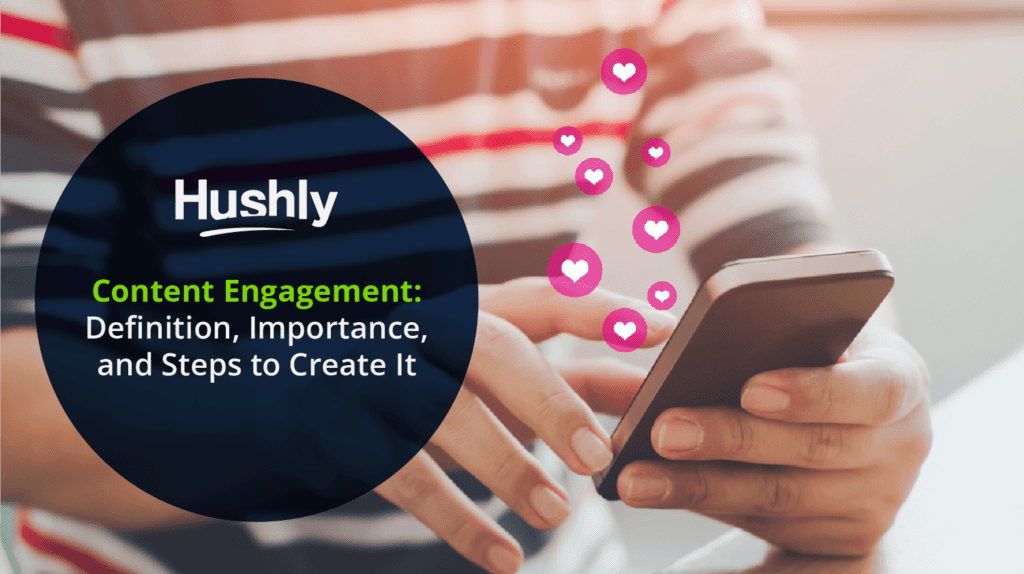Your ideal buyer has found your website thanks to your great SEO practices. They’re now on the landing page, hoping for an answer to a question they’ve been asking themselves for days.
This buyer has a problem and is ready to spend money on a solution. It happens that your company is in a position to provide that solution. You’ve got them where you want them, with their eyes on your website ready to consume content that will increase their likelihood of doing business with you. What happens next?
If your website’s content strategy is strong enough, this customer should find themselves in an engaging rabbit hole of information that answers their questions, reassures them that your product is right for them, and removes friction from the buying process.
Anything less than this is simply not going to compete with the modern advancements in marketing and technology.
Hushly knows this, which is why we created this introduction to content engagement. We’ll cover information on the definition of content engagement and how to measure it, as well as some concrete steps on how to increase audience engagement.

What is Content Engagement?
In broad terms, content engagement is the myriad ways users can react when consuming your content. The phrase content engagement doesn’t indicate a positive or negative reaction to the content, but rather the decision of the customer whether to amplify, consume and move on from, or ignore the content.
Every action, or inaction, that a user reacts with can provide valuable insight into the quality and value of the content they’re engaging with. This is the core principle behind content engagement.
What Does It Mean to Engage in Content?
A user may decide the information in your content is so valuable that they feel they need to share it with others. They may disagree and leave a comment. They may simply like the post or even ignore it completely and keep scrolling. Each of these technically represents content engagement.
Content engagement examples include social media engagement like clicks, shares, and other direct metrics like bounce rate. When marketers discuss content engagement, they are generally referring to concrete metrics like these.
In other words, content engagement is an important measure of the quality of your content.
Why is Content Engagement Important?
Knowing how strong your content is matters a great deal to your overall content strategy. Identifying which content is performing well can help you increase the efficiency of your marketing budget and direction.
It’s also the best way to build a loyal and interested customer base. In other words, a customer base that will be excited and knowledgeable enough to try out new features and give sophisticated feedback on how to improve your product.
What Content Gets the Most Engagement? 3 Examples of Engaging Content
Content that gets the most engagement often invites engagement by its very nature, like a poll or a quiz.
Here are three examples of content to create when you want to boost your engagement.
1. Polls and Quizzes
A well-conceived poll or quiz can elicit an emotional response from a customer. If a customer feels strongly about the question you asked, they’re far more likely to engage with it.
Polls and quizzes can encourage a customer to think about how your product affects their daily lives.
2. Case Studies
A case study is an example of a situation where your company found a problem and solved it. It’s a recap of the way your company successfully delivered value to a satisfied customer. The best case studies involve interviews with representatives from the company you worked with as well as in-depth explanations as to how your company recognized the opportunity for growth and executed that vision.
3. User-Generated Content
Polls show that users trust user-generated content more than content they perceive to have been created by a marketing team. They are more likely to engage with and enjoy this content, which means your company must find a way to identify UGC and add it to an accessible hub.
How Do You Measure Content Engagement?
The first step towards measuring content engagement is deciding what success means. You’ll need to know what your goals are concerning content engagement, including who you’re engaging with and why. Then, you can identify which engagement metrics will be most important for you to track.
Metrics like the ones we list below are invaluable data points in your quest to optimize content engagement. However, don’t forget about the context of these figures. They should each be weighed according to their importance to your overall plan.
- Conversion Rate: Your best content is that which drives the most customers to buy your product.
- Bounce Rate: A measure of visitors who enter your website only to immediately leave it. A high bounce rate could indicate poorly executed or difficult-to-find content.
- Page Views Per Session: A sign of how many different web pages a user opened during a single session. More page views mean the user browsed more of your content.
- Time on Site: A measure of how much time the user spent on your website.
- Likes, Comments, Shares: Likes and shares are the most important to track for a social engagement strategy. Comments are also a great place to encourage discussion and build a community of users.
What is a Content Engagement Strategy?
A content engagement strategy is your plan to create content that satisfies customers’ needs and drives engagement. It can be implemented on its own or as part of a broader go-to-market strategy.
All of this is done in the service of improving sales conversions.
4 Elements of Creating Engaging Content
Ideally, a content engagement strategy has these elements:
1. Idealized Buyers
Buyer personas are the best way to theorize your ideal customer and form a plan to speak to them directly.
2. Identification of Pain Points
You should already have an idea of what kinds of problems the customer could be facing before creating content for them.
3. Efficient Solutions
Finding problems is easier than building solutions. Design content around your unique ideas. This is how you’ll build credibility and trust.
4. Plan to Drive Conversions
All content should be designed to increase conversions, not necessarily engagement. Don’t forget that engagement is just another measure of content quality, not the only or most important factor.
How Do You Make Digital Content Engaging?
Buyers today expect personalized content. To keep up with the demands of the marketplace, Hushly recommends thoroughly personalizing content to your most valuable buyers. This includes things like:
- Adaptive content hubs
- Dynamic websites
- Personalized self-nurturing landing pages
- A constantly refined data-driven approach
Consider personalizing messaging all the way down to website text, banners, logos, and calls to action.
Are you ready for Hushly to take on the job of developing your web content to drive engagement and boost conversions? Get a personal demo today.




